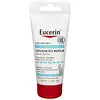What's inside
What's inside
 Key Ingredients
Key Ingredients

 Benefits
Benefits

 Concerns
Concerns

 Ingredients Side-by-side
Ingredients Side-by-side

Glycerin
HumectantUrea
BufferingGlyceryl Stearate
EmollientDibutyl Adipate
EmollientStearyl Alcohol
EmollientDicaprylyl Ether
EmollientCetearyl Alcohol
EmollientSodium Lactate
BufferingTapioca Starch
Glyceryl Stearate Se
EmulsifyingLactic Acid
BufferingSodium PCA
HumectantArginine Hcl
Skin ConditioningGlycine
BufferingAlanine
MaskingCarnitine
CleansingHelianthus Annuus Seed Oil
EmollientDimethicone
EmollientXanthan Gum
EmulsifyingPentylene Glycol
Skin ConditioningPhenoxyethanol
PreservativeSodium Cetearyl Sulfate
CleansingGlycerin, Urea, Glyceryl Stearate, Dibutyl Adipate, Stearyl Alcohol, Dicaprylyl Ether, Cetearyl Alcohol, Sodium Lactate, Tapioca Starch, Glyceryl Stearate Se, Lactic Acid, Sodium PCA, Arginine Hcl, Glycine, Alanine, Carnitine, Helianthus Annuus Seed Oil, Dimethicone, Xanthan Gum, Pentylene Glycol, Phenoxyethanol, Sodium Cetearyl Sulfate
Water
Skin ConditioningGlycerin
HumectantButyrospermum Parkii Butter
Skin ConditioningOctyldodecanol
EmollientCaprylic/Capric Triglyceride
MaskingVitis Vinifera Seed Oil
EmollientBehenyl Alcohol
EmollientDistarch Phosphate
AbsorbentGlyceryl Stearate Se
EmulsifyingOenothera Biennis Oil
EmollientGlycyrrhiza Inflata Root Extract
Skin ConditioningCeramide NP
Skin ConditioningTocopherol
AntioxidantSodium PCA
HumectantGlycine
BufferingArginine Hcl
Skin ConditioningDecylene Glycol
Skin ConditioningPolyglyceryl-3 Methylglucose Distearate
EmulsifyingCarbomer
Emulsion StabilisingCitric Acid
BufferingEthylhexylglycerin
Skin ConditioningSodium Cetearyl Sulfate
CleansingCaprylyl Glycol
EmollientSodium Hydroxide
BufferingAscorbyl Palmitate
AntioxidantTrisodium EDTA
Phenoxyethanol
PreservativeSodium Benzoate
MaskingWater, Glycerin, Butyrospermum Parkii Butter, Octyldodecanol, Caprylic/Capric Triglyceride, Vitis Vinifera Seed Oil, Behenyl Alcohol, Distarch Phosphate, Glyceryl Stearate Se, Oenothera Biennis Oil, Glycyrrhiza Inflata Root Extract, Ceramide NP, Tocopherol, Sodium PCA, Glycine, Arginine Hcl, Decylene Glycol, Polyglyceryl-3 Methylglucose Distearate, Carbomer, Citric Acid, Ethylhexylglycerin, Sodium Cetearyl Sulfate, Caprylyl Glycol, Sodium Hydroxide, Ascorbyl Palmitate, Trisodium EDTA, Phenoxyethanol, Sodium Benzoate
Ingredients Explained
These ingredients are found in both products.
Ingredients higher up in an ingredient list are typically present in a larger amount.
We don't have a description for Arginine Hcl yet.
Glycerin is already naturally found in your skin. It helps moisturize and protect your skin.
A study from 2016 found glycerin to be more effective as a humectant than AHAs and hyaluronic acid.
As a humectant, it helps the skin stay hydrated by pulling moisture to your skin. The low molecular weight of glycerin allows it to pull moisture into the deeper layers of your skin.
Hydrated skin improves your skin barrier; Your skin barrier helps protect against irritants and bacteria.
Glycerin has also been found to have antimicrobial and antiviral properties. Due to these properties, glycerin is often used in wound and burn treatments.
In cosmetics, glycerin is usually derived from plants such as soybean or palm. However, it can also be sourced from animals, such as tallow or animal fat.
This ingredient is organic, colorless, odorless, and non-toxic.
Glycerin is the name for this ingredient in American English. British English uses Glycerol/Glycerine.
Learn more about GlycerinGlyceryl Stearate Se is a self-emulsifying (SE) form of glyceryl stearate. Self-emusifying means this ingredient automatically blends with water. It is an emulsifier, emollient, and cleansing agent.
As an emulsifier, Glyceryl Stearate Se prevents ingredients such as oil and water from separating. It is also a surfactant, meaning it helps cleanse the skin. Surfactants help gather oil, dirt, and other pollutants so they may be rinsed away easily.
Emollients help your skin stay smooth and soft. It does so by creating a film on top of the skin that helps trap moisture in.
Learn more about Glyceryl Stearate SeThis ingredient is an amino acid that helps build proteins and moisturizes skin. It is already present in our skin as our bodies produce them naturally.
Glycine already plays a role in helping keep our skin moisturized as amino acids transport moisture throughout our skin.
As collagen is made up of glycine and other amino acids, it is believed glycine may help our skin produce more collagen.
Learn more about GlycinePhenoxyethanol is a preservative that has germicide, antimicrobial, and aromatic properties. Studies show that phenoxyethanol can prevent microbial growth. By itself, it has a scent that is similar to that of a rose.
It's often used in formulations along with Caprylyl Glycol to preserve the shelf life of products.
Sodium Cetearyl Sulfate is a type of sulfate.
Sodium PCA is the sodium salt of pyroglutamic acid. It is naturally occurring in our skin's natural moisturizing factors where it works to maintain hydration.
The PCA stands for pyrrolidone carboxylic acid, a natural amino acid derivative.
This ingredient has skin conditioning, anti-inflammatory, and humectant properties. Humectants help hydrate your skin by drawing moisture from the air. This helps keep your skin moisturized.
Learn more about Sodium PCA